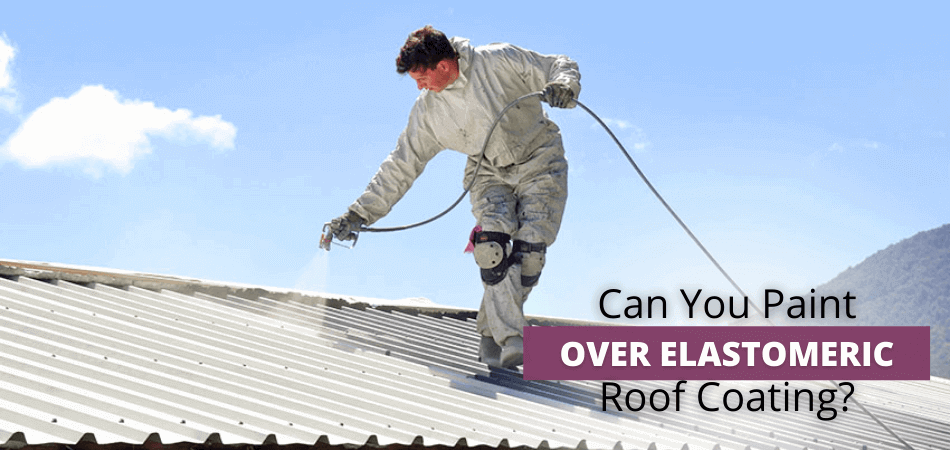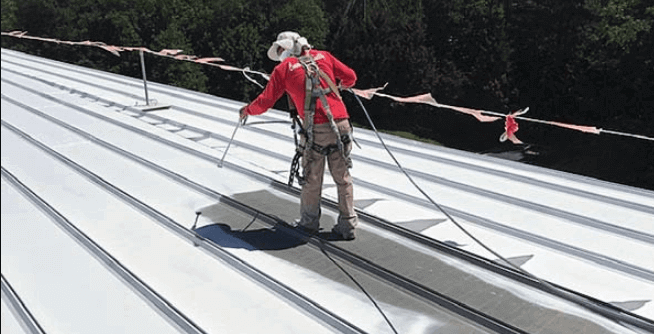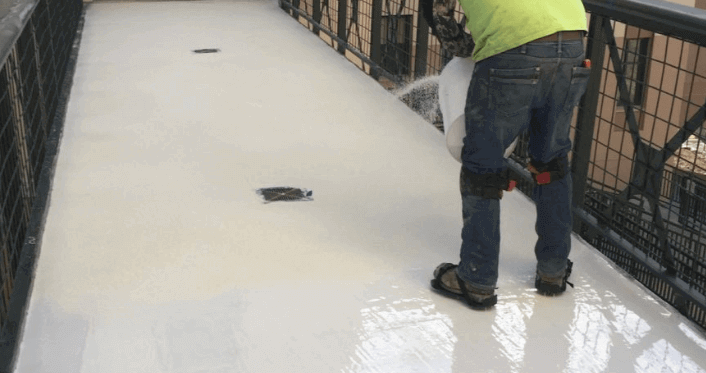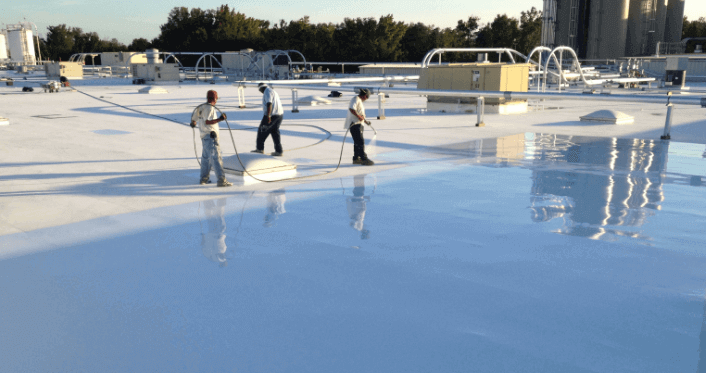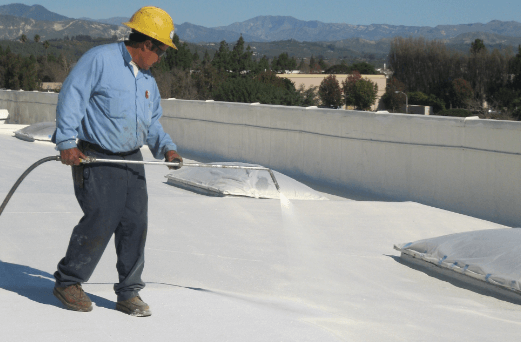Being a professional painter, James never limits himself to his job only. He wants to utilize his decade of painting experience by helping people who...Read more
Roof coating is used on several roofs to reduce biological growth, elongate life expectancy, promote solar reflectivity, and enhance resistance to external impact. So, if you’re building and considering what to use for your ceiling, then elastomeric paint is a great option you can use as it lasts over 10 years without eroding. But, in the long run, you might want to change the color of your ceiling paint and might ask, “Can You Paint Over Elastomeric Roof Coating?”
It’s possible to paint over an elastomeric roof coating, but that won’t be an effortless task. This is because an elastomeric coating is not a paint and gives a hard time accepting another painting over it. But, with the right preparation, you can paint over an elastomeric roof coating.
This article will show you how you can paint over elastomeric roof coating. Additionally, we have outlined the benefits and limitations of painting over elastomeric roof coating. So, buckle up, and let’s ride.
Contents
Can You Paint Over Elastomeric Roof Coating?
Can You Paint Over Elastomeric Roof Coating? You can paint a good acrylic paint over an elastomeric roof coating to refresh its appearance and give it a better finish. However, before painting over the elastomeric roof coating, it’s ideal for you to clear off all grimes, dirt, chalk, mildew, and dust before painting over it.
Notably, elastomeric paints are thicker than normal latex paints and are designed to last for around 10 to 20 years. So, when considering applying another paint on it, you want to be careful about the paint you’re using. Elastomeric paints are flexible, thicker, and are ideal for commercial roofing. Now, re-coating a paint that is not flexible over it will be a waste of time and paint.
So, we recommend that before painting, understand the type of paint that will fit perfectly for your elastomeric coating. Top-quality acrylic latex paint is a good example of a type of paint that will fit the elastomeric coating.
But do it properly to avoid getting pinholes. Pinholes are holes gotten from busted bubbles created when moving the roller too quickly on the roof surface. When these bubbles burst, they leave spaces on the surface that allow water to permeate the roof and damage it. So, whatever you’re painting upon your elastomeric coating, ensure that it fills in the pinholes.
Types of Elastomeric Coating
While it’s possible to paint over elastomeric roof coating, it’s also important to understand which kind of paint we’re talking about. That said, let’s consider them below.
Acrylic:
This is a more popular class of elastomeric coating. It is widely used, partly because of its high affordability compared to the other types of elastomeric roof coatings. Notably, it is ideal for sliding surfaces and not on horizontal surfaces. This is because, when applied on a flat horizontal surface, it can return to liquid if standing water on the roof’s surface is constantly upon it.
The coating of acrylic elastomeric coating comprises 52% solid composites and 48% water. Thus, when you’re applying it on your roof, over half of the coating will evaporate into the air. Also, even though it’s cheaper than the other coatings, you’ll need to use more paints to make up for the lost ones.
Urethane:
On the other end of the line is the urethane elastomeric roof coating. Notably, the urethane coating is more expensive than the acrylic and silicone coating. Moreover, one thing to note about urethane is that it also doesn’t do well in contact with water.
Silicone:
The third type of elastomeric coating is the Silicone resin-based elastomeric coating. This resin-based coating comprises 96% solid composites and 4% carriers. So, when applied to your roof, exactly 96% of the coating lasts on your roof. Additionally, this type of coating is ideal for flat roofs, as it’s water-resistant (or, in a clearer sense, can withhold standing water).
For price and performance, the silicone elastomeric coating is average. In comparison with acrylic paints, they are more water-proof and, of course, more expensive. So, if you’re looking for a roof coating that can withstand the elements, then you shouldn’t go further. Just consider the silicone elastomeric roof coating.
What Are the Advantages of Paint Over Elastomeric Roof Coating?
Painting over elastomeric roof coating has several advantages, which cannot be overlooked.
Prolonged Life Expectancy:
Applying paint over your elastomeric roof coating extends the roof’s life expectancy. Why so? It reinforces the surface with an additional protective layer. Thus, enabling your roof to last longer than before. So, if your elastomeric roof was over 7 years old and you’re in the last year, adding high-quality acrylic paint over that surface will sure increase its lifespan.
That way, you don’t have to worry about any leakages or damaged roofing. But when applying your paint upon the roof, if you don’t want to use a brush or roller, you can get an airless paint sprayer for roof coating to make your work easier.
Better Appearance:
Even as the elastomeric coating is a high-quality material, it can still wear off because of extreme climate change. Excessive consistent pressure from high temperatures—rainfall, snow, and sunshine—and other factors can affect the appearance of the roof coating. However, when you repaint it properly, you will bring back to life the appearance of the roof coating.
So, if you’ve got an old elastomeric roof coating for years now, you should consider repainting it and giving your building a newer and better look.
Reinforced Thickness:
When you apply a fresh layer of elastomeric coating on your roof, and it solidifies, it forms a layer of the membrane. This protects the main surface of the roof or wall from eroding as time goes by. But, over the years, as your roof stays under the direct impact of climatic impact—especially when the time of its integrity is about to elapse, its texture will give in to wear and tear.
So, by reapplying paint over your elastomeric roof coating, you will add more layers of protection to your coating. Thus, enhancing the protection.
Waterproof:
Since the elastomeric coating is waterproof by nature, adding any additional painting will help reinforce the water-resistant nature, especially with good water-resistant paint. This will be a safer and more preferred choice.
Now that we’ve seen the various benefits of painting over your elastomeric roof coating let’s consider the disadvantages in the next segment.
What Are the Drawbacks of Paint Over Elastomeric Roof Coating?
There are some drawbacks of painting over an elastomeric roof. What are they?
More Expensive:
The overall process of repainting your elastomeric roof may be quite expensive in the long run. This is because you might eventually need to patronize a professional painter if you don’t think you can do it by yourself. The good thing about elastomeric paint is that it lasts for a much longer time than other kinds of paint. However, the overall process may cost you some extra cash while repainting it.
One major reason why you might need a professional painter to do the job is that you don’t want the paints to leave some air bubbles on the job.
May Require Backrolling:
As we’ve stated above, painting or repainting over an elastomeric roof is a very detailed process and requires maximum carefulness. For a start, you shouldn’t apply your painting or repainting in an extremely cold or moist temperature, e.g., snowy seasons. To effectively permeate your roof, you might need to backroll every layer before going ahead.
Depending on The Quality of Your Roof:
Although elastomeric coatings are ideal for prolonging the life expectancy of your roof, it depends on the quality of the roof. If you’re planning on repainting a deteriorated and seriously corroded roof, then you should reconsider. Why so? The surface is already damaged, and the only solution is to replace the roof first before going on to do something else.
Selective Paint Options:
Elastomeric roof coatings are pretty difficult to repaint with other paints. A first challenge is that, since it’s denser than other paints, it will cover only a small square foot—thus, requiring more products. Now, noting that the elastomeric materials are more flexible, water-resistant, and thicker than regular paint, it will be much harder combining with less flexible paint. That makes the elastomeric roof coating quite picky.
Should You Paint Over Elastomeric Roof Coating?
You can choose to paint over elastomeric roof coating if the roof’s surface is worn out and eroded. Also, if the roof coating has elapsed, its time of consistency and has given to the weather elements. Generally, the roof can look eroded by weather or even have some leakages. In times like this, the materials may give in and become weak. If this is the situation for your roof, then you’d need to replace the roof.
On the other hand, if it’s only the texture of your elastomeric roof coating that wears off, it’s ideal for you to repaint it as immediately as you can. Also, if you spot pinholes or unequal textures of the coating, then don’t fail to repaint it.
How to Paint Over Elastomeric Roof Coating?
To paint over elastomeric roof coating, follow the steps below.
Prepare the Surface
First of all, clean off all grimes, dirt, dust, chalk, and mildew from the roof coating. For mildew, treat it with a bleach-water ratio of 3:1, then allow it on the roof’s surface for about 3-5 mins. When you’re done, rinse it properly with plain water.
After that, smoothen the surface properly with 220-grit sandpaper. This enables the paint to properly stick to the roof’s surface seamlessly.
Clean the Surface
After that, carefully power-wash the surface with ONLY normal water while ensuring that the water doesn’t enter any opening. Then, scrutinize the roof properly, ensuring to seal off any crack or hole on the roof using a siliconized caulk, then allow it for a while.
Dry the Surface
The next thing to do is to dry the roof’s surface using a dry paper towel.
Apply a Bonding Primer
Although sanding the roof’s surface is good enough to smooth the surface, you still need a primer to ensure that the paint sticks to the elastomeric surface seamlessly. So, apply a layer of primer on the surface of the roof coating and allow it to dry completely.
Apply Your Paint
When the bonding primer has dried off completely, it’s time to apply the paint using a roller or brush. Then, drag the brush from across the roof from top to bottom until you cover the full span.
Conclusion
Can You Paint Over Elastomeric Roof Coating? Yes, you can apply paint over elastomeric roof coating. As you are now at the end of this article, you know how you can apply another paint on top of your elastomeric paint surface. However, since the Elastomeric paint is flexible, denser, and water-resistant, it’s more selective and difficult to paint another paint over it.

Being a professional painter, James never limits himself to his job only. He wants to utilize his decade of painting experience by helping people who don’t have much knowledge about painting. That is why he created this site Paintersprayer, where he will share all of his experiences about painting with a broader audience. In Paintersprayer, James will share his knowledge and skill and help people select the best paint spraying and other painting tools.
More Posts
